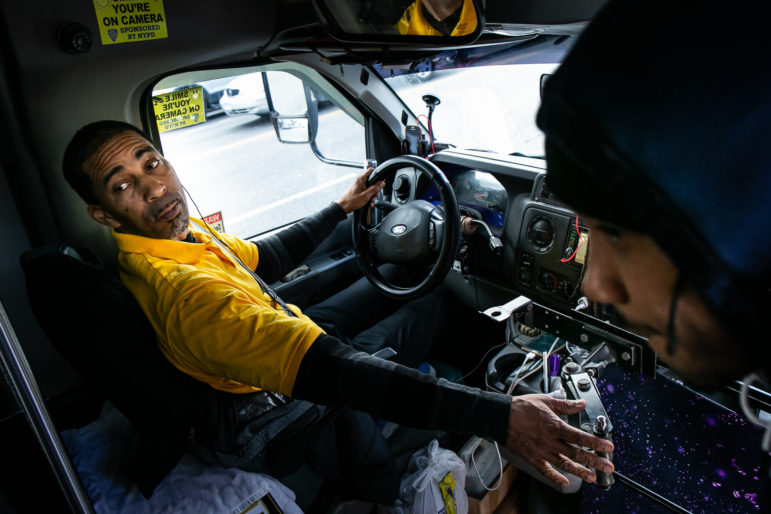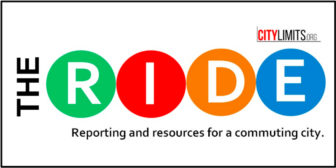
Adi Talwar
On a recent Tuesday, Winston Williams picking up passengers on Flatbush Avenue in Brooklyn. Williams owns a Dollar Van service that plys between Kings Plaza Shopping center and Downtown Brooklyn on Flatbush Avenue.
This story was produced through the City Limits Accountability Reporting Initiative For Youth (CLARIFY), City Limits’ paid training program for aspiring public-interest journalists.
Winston Williams has been driving a commuter van—sometimes known to customers as “dollar vans”—since 1996. His typical route is in Brooklyn, along Utica and Flatbush avenues, so when he heard about the pending L train shutdown, he’d initially hoped to serve as an option for commuters affected by the closure.
It’s been almost a year since Williams says he submitted applications to expand his services into Bushwick and Williamsburg, as well as the Bronx. And while the Department of Transportation has approved his Bronx application, it has not yet approved those for the areas in Brooklyn, according to Williams.
As the city prepares for the L train shutdown in April, riders along the route will need to find alternative transit options. The city and the MTA’s mitigation plan includes sending shuttle buses over the Williamsburg Bridge, as well as extra service on nearby subway lines. And while luxury rideshare services like “Chariot” and “The New L” have pitched themselves as an option to accommodate stranded L train riders, commuter van drivers feel their services have been overlooked by the city, and are lobbying to be included as part of the solution.
The DOT, however, says it won’t approve applications for commuter van services looking to expand into L train-affected areas if their proposed routes overlap with those of the MTA’s shuttle buses—an effort, most likely, to mitigate some of the congestion that’s expected on the Williamsburg Bridge once L train service halts.
But commuter van drivers feel it’s unfair for them to be cut off from serving these areas while taxis, for-hire vehicles and other rideshare services aren’t.
“They’re not going to stop the cars, the Uber cars, Chariot and all these multi-millionaire dollar companies,” Williams says. “No part of that is fair.”
Commuter vans are privately-owned van services that typically operate in neighborhoods that are under-served by public mass transit or taxis, including Jamaica, Flushing, and Flatbush. The vehicles, which are licensed by the DOT and city’s Taxi and Limousine Commission, can fit between nine and 20 passengers, and usually charge a fee of just a few dollars—what initially earned them the “dollar van” moniker.
Leroy Morrison, owner of Alexis Van Lines, is a 30-year veteran of the industry and vice president of the Commuter Van Association of New York, which advocates for the city’s fleet of commuter van drivers—a group he describes as largely made of minority, immigrant small business owners who service the most transit-starved parts of the city.
Dollar Van Fans Say They Won’t Wait for the Bus
“We fill the gap that the MTA doesn’t,” he said, saying commuter vans have been integral to keeping to city moving during times of crisis like transit strikes, the 2003 blackout and 9/11. “We are always here for this city, and we are still going to be here for the city.”
Morrison says he applied for a license nearly two years ago to run a commuter-van route from North 7th Street in Williamsburg to the Lower East Side, with buses that can carry up to 20 passengers at a time, with the hopes of finding customers affected by the L train closure.
But like Williams, he says his license has still not been approved.
Morrison says he knows of several other commuter-van operators whose applications to service L-train areas are in a similar limbo, and has been speaking out about the issue for at least the last year.
“When the city’s in crisis, you guys call the commuter vans,”Morrison says. “We feel like we are insiders and we should get some of the work. Not like these outside companies that come here with their apps.”
The DOT, in a statement, says it is “actively engaged with commuter-van operators interested in adding additional service during the L train tunnel reconstruction period,” but pointed to a section of the city’s Administrative Code that bans commuter vans from operating along routes served by MTA buses.
“DOT has therefore rejected applications to provide service that would fully or considerably duplicate planned MTA shuttle routes from Williamsburg to Manhattan, or placed such applications on hold, while DOT provides the operators an opportunity to revise their applications so that they do not duplicate or interfere with MTA bus service,” an agency spokesman said.
“We are a licensed commuter van service and you’re trying to tell us you’re going to shut us out of the city?” Williams counters. “They’re leaving the room for Uber, Lyft, Ford Chariot.”
Those companies, however, are regulated differently than commuter vans, which must operate along specific routes approved by the DOT. Lyft and Uber are classified as For-Hire Vehicles, and Chariot operates as a black car service, which has its own set of rules and requirements, including that drivers contribute to a workers compensation fund and submit records of their trips to the TLC, which is not required of commuter vans, according to the agency.
Once the L train shutdown is in effect, the Williamsburg Bridge will be subject to High Occupancy Vehicle (HOV-3) restrictions from 5 a.m. to 10 p.m., meaning all vehicles crossing the span will need to carry at least three people or risk being ticketed—an effort to mitigate some of the congestion that’s likely to come from riders driving to and from Manhattan instead.
Marco Conner, co-deputy director at Transportation Alternatives, says that since the DOT has declined to create dedicated bus lanes on the bridge during the shutdown—something his organization is pushing for—it will be especially important to prioritize as much space as possible for MTA shuttle buses, which can hold the largest number of riders.
“We don’t oppose commuter vans. They serve a purpose, typically in areas the city fails to serve with adequate transportation. However, with 200,000 riders daily between Manhattan and Brooklyn we need to prioritize the most space efficient modes of commuting,” he says. “The more commuter vans there are the more the HOV lanes will be clogged.”
Adam Davidson, a transit expert and associate on the Urban Mobility Team at the World Resources Institute Ross Center for Sustainable Cities, agrees that public buses will be key to moving as many L train riders as possible.
“From a capacity, congestion, and emission standpoint it is clear that strong, reliable bus service should be designed to be the most valuable alternative for people who don’t switch to other subway lines,” he says.
Still, commuter vans and other ride-sharing services would be preferable to riders opting for Single-Occupancy Vehicle trips, or SOVs.
“Commuter vans and shared rides alone won’t solve the problem (the capacity is much too low), but they can help at the margins,” he says. “Anything that makes choosing non-SOV travel easier for New Yorkers will only keep the roads clearer.”
That’s one point that Jaime Getto, founder and president of the luxury shuttle bus service known as
“The New L,” makes about her start-up, which will partner with existing taxi and limousine companies to transport customers on weekdays between Brooklyn and Manhattan, where passengers can enjoy perks like charging ports, WiFi and breakfast for $155 a month.
“We are actually packing 14 people into each vehicle, so theoretically you are taking cars off the road,” she says.
Getto is also skeptical of whether the MTA and the city’s plan for the L train shutdown is sufficient to accommodate all of the people who will be affected by it, creating a market for services like hers.
“The bulk of their plan involves just rerouting passengers to the next closest subway, which, as New Yorkers, we know are already notorious for being late, therefore they are overcrowded and vice versa. If we haven’t seen improvements in the infrastructure today, how can we expect that it wouldn’t be chaos without having some other form of transportation?” she asks.
Morrison, who says his buses can fit up to 20 passengers, agrees.
“The MTA does not have enough service for the public,” he says.
At the MTA’s monthly board meeting this week, however, New York City Transit President Andy Byford assured reporters that the alternative bus service the agency is planning will be adequate.
“This is a flexible plan that we can flex to either add service, or if necessary, to reign in service if we’re providing too much,” he said. “We will have additional buses standing by.”
Eric Goldwyn, a research scholar at New York University’s Marron Institute of Urban Management and an expert on commuter vans, saysthat since commuter van businesses tend to rely on high turnover rates, it may not make sense for them to cross boroughs during the L train closure—but he thinks the vehicles can help fill in other service gaps.
“I think the interesting role that dollar vans could play in the L train shutdown is moving people to subway stations and throughout the borough of Brooklyn, rather than going over the bridge,” he says.
City Councilman Jumaane Williams, whose Brooklyn district is a popular area for commuter vans, says he hopes to see the industry given some kind of opportunity to be included during the L train shutdown
.
“Commuter van drivers and company operators have faced additional hurdles and barriers to expanding their services, and this definitely extends to the L Train shutdown plan,” he told City Limits in an email. “DOT has also helped the industry on some our legislation in the past, and I hope that they are less myopic in developing transportation alternatives than in these cases.”
Morrison thinks he and othercommuter van drivers deserve a chance to be involved, as most are small business owners just trying to offer a service and make ends meet.
“They can’t discriminate [against] us,” he says. “We deserve a fair share, too, like anyone else.”










4 thoughts on “Dollar Van Drivers: City Should Let Us Help During L-pocalypse”
Pingback: Dollar Van Drivers Feel Left Out As Commuter Services Gear Up for L Train Shutdown - BKLYNER
Pingback: Greenback Van Drivers Really feel Left Out As Commuter Companies Gear Up for L Prepare Shutdown - Gadgets Now Website
Pingback: Wednesday’s Headlines: Kevin Parker Needs Help Edition – Streetsblog New York City
Pingback: Dollar Van Fans Say They Won’t Wait for the Bus | NYC Informer